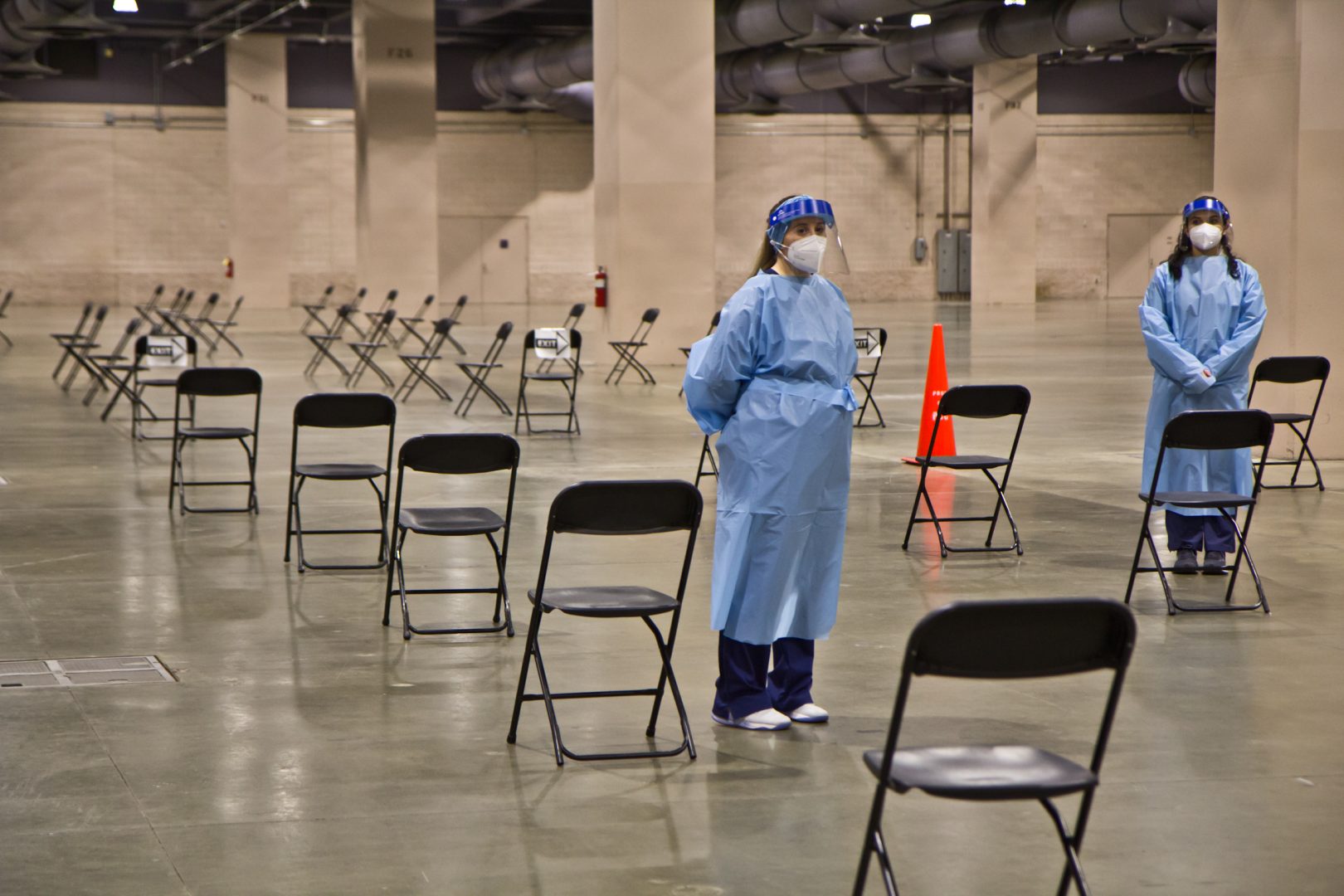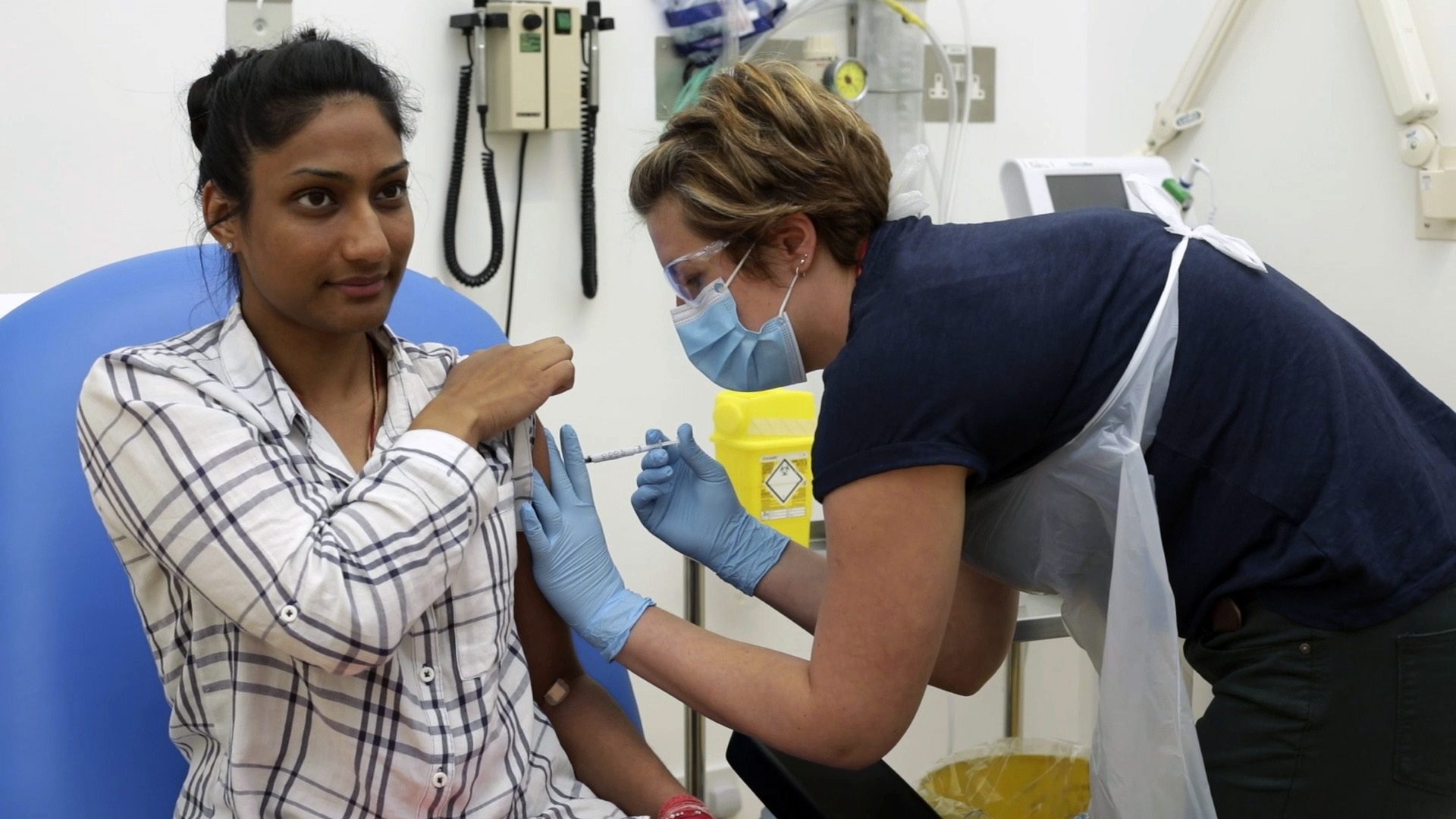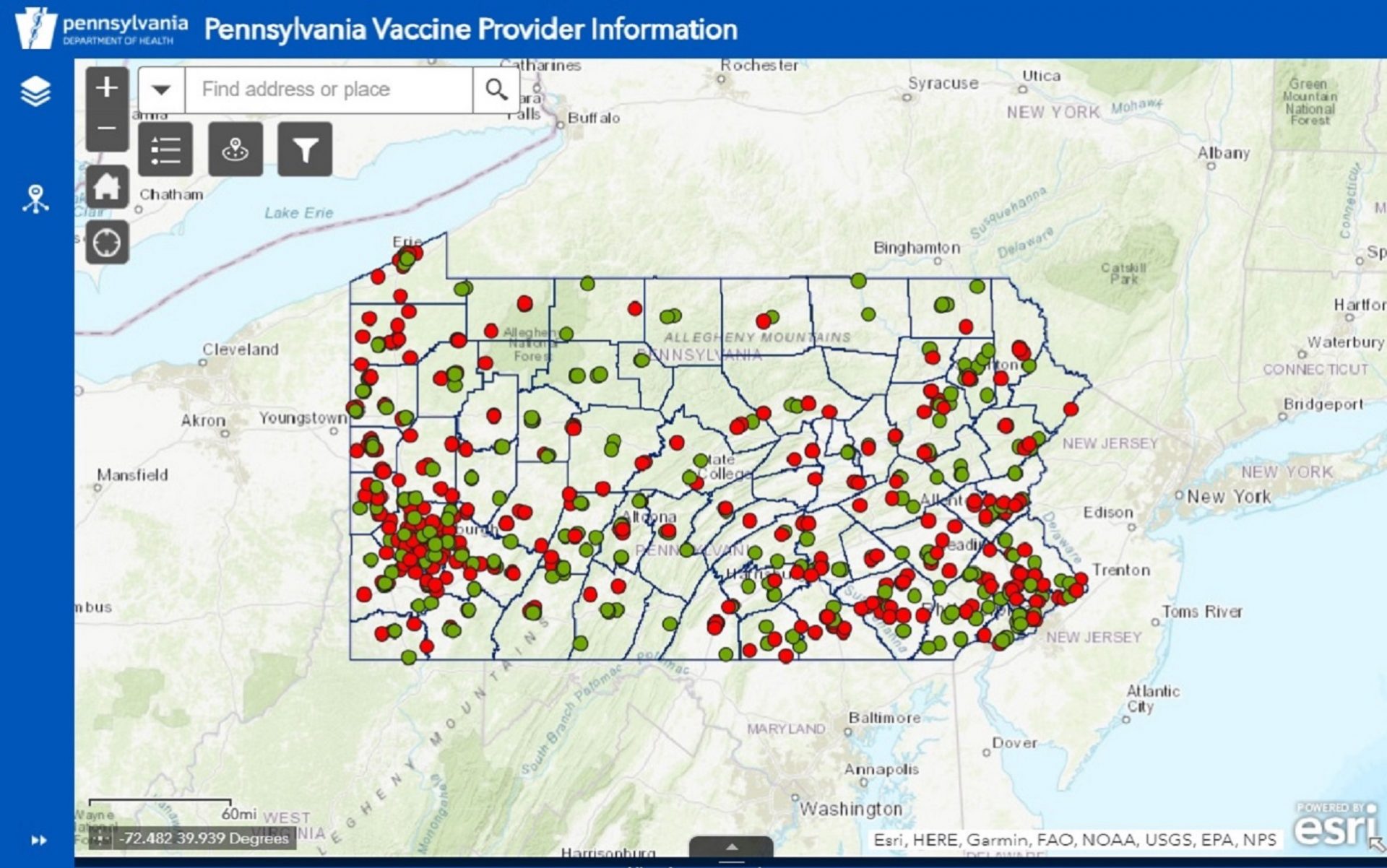
After receiving the vaccination, patients wait under observation at the community vaccine clinic at the Pennsylvania Convention Center.
Kimberly Paynter / WHYY

After receiving the vaccination, patients wait under observation at the community vaccine clinic at the Pennsylvania Convention Center.
Kimberly Paynter / WHYY

Kimberly Paynter / WHYY
After receiving the vaccination, patients wait under observation at the community vaccine clinic at the Pennsylvania Convention Center.
(Harrisburg) — While many Pennsylvania health care providers report they are out of COVID-19 vaccines, at least a half-million doses distributed to them may not have been given to people yet.
Two separate data analyses show that more than half of the vaccines distributed to pharmacies and health clinics in Pennsylvania have not been reported as used. The data comes from the Centers for Disease Control and Prevention and from the Pennsylvania Department of Health.
Health officials say the discrepancy is due to a number of factors, including lags in reporting and lack of personnel to administer the vaccines. It results in a situation where no one is certain how many Pennsylvanians have been vaccinated or what is happening with thousands of vials of the life-saving inoculation.
Every week since mid-December, states have requested vaccines from Operation Warp Speed, the federal coronavirus task force. Drugmakers Moderna and Pfizer-BionTech ship those vaccines directly to health care providers as designated by state health agencies.
Once that happens, the vaccine is reported as “distributed,” said Centers for Disease Control and Prevention spokesperson Kristen Nordlund. The CDC is keeping track of those numbers.
After the health care provider uses up a batch of vaccines, it reports that information to state and federal agencies, and the CDC keeps track of that as well.
Since December, Pfizer and Moderna have shipped more than 1.3 million vaccine doses to health care providers in Pennsylvania, CDC data show. Pennsylvania has reported to the CDC that just over 605,400 doses have been used as of Jan. 22.
Vaccine providers across Pennsylvania have reported just 46 percent of their vaccines were administered, CDC data show. By that metric, the state ranks 28th nationwide, according to Jan. 21 CDC data compiled by Becker’s Hospital Review.
In comparison, at the top of that list North Dakota reported 74 percent of its vaccines were given to people. West Virginia reported 68 percent were used.
More populous states such as Texas and New York also showed higher percentages of vaccines reported as having been used. Texas has administered 1.4 million doses, or 58 percent of what it received. New York reported 1 million doses, or 51 percent of its supply, were used.
Transforming Health analyzed Jan. 20 data, which produced slightly different results. Here, Pennsylvania ranked 26th:
The discrepancy exists nationwide, with some states doing better than others. As of Wednesday, about 36 million vaccine doses were distributed in the U.S. About 16.5 million had been administered—46 percent.
The CDC data changes every day. A Transforming Health analysis found that Pennsylvania fluctuated between the 26th and 28th rank out of 50 states over the past few days.
A separate analysis of data provided by the Pennsylvania Department of Health shows a similar result: hundreds of thousands of vaccine doses have not yet been reported as used.
According to that data, Pennsylvania has received 1.2 million doses so far, said Department of Health spokesperson April Hutcheson. So far, 543,329 doses have been administered to people. That leaves about 629,000 doses not yet reported as having been used.

University of Oxford / AP Photo
In this screen grab from video issued by Britain’s Oxford University, a volunteer is injected with either an experimental COVID-19 vaccine or a comparison shot as part of the first human trials in the U.K. to test a potential vaccine, led by Oxford University in England on April 25, 2020. About 100 research groups around the world are pursuing vaccines against the coronavirus, with nearly a dozen in early stages of human trials or poised to start.
Part of the number shortfall is due to some pharmacies, which are allowed to take up to three days to report their numbers back to the state, Hutcheson said.
In addition, an insufficient number of personnel are causing a bottleneck in administering vaccines. Hutcheson noted that with this inoculation, people need to be monitored for 15 minutes to make sure they don’t have an allergic reaction.
The Pennsylvania Emergency Management Agency is working with the state health department to set up mass vaccination sites, Hutcheson said. “We also know that some counties and health systems are planning their own mass vaccination clinics when more vaccine is available from the manufacturers.”
Hutcheson said Thursday that Pennsylvania health care providers are getting 143,275 vaccine doses per week, and during the past two days have inoculated 58,000 people.
“At the end of the day, the most important thing for people to understand is there is a limited amount of the vaccine, the providers are working around the clock, and we encourage that and want it to happen as quickly as possible,” Hutcheson said. “People have to have patience in this process.”
The situation in Pennsylvania is one facet of the widespread chaos in the coronavirus vaccine rollout across the country. President Joe Biden’s administration recently said former President Donald Trump left them “a complete lack of a vaccine distribution strategy.” Trump’s Operation Warp Speed was criticized for putting too much responsibility on states and lacking sufficient federal guidance.
In Pennsylvania, the need to swiftly administer vaccines became more urgent following a Jan.19 Pennsylvania Department of Health policy change that expanded who is eligible for the shot.
Under the change, people 65 and older, as well as some younger people with certain medical conditions, can get the vaccine. An estimated 3.5 million Pennsylvanians fall into those categories.
That policy change had people like Alexis Gomez of Chester County rushing to book an appointment using an interactive map provided by the state. There, she found hundreds of red and green dots representing health care providers and pharmacies that administer the COVID-19 vaccine. Green means they have vaccines. Red means they don’t.

Screen capture
A Jan. 22 screen capture of the Pa. Department of Health interactive map. The state is directing people who want the COVID-19 vaccine to this site.
“It’s a mess,” said Gomez, who is in her 60s and has a medical condition that puts her at risk for the most severe effects of the virus. Gomez said she “spent hours online and cannot find a site within 50 miles where I can even get on a waitlist.”
In Cumberland County, 39-year-old Shaun Turner said he contacted several local vaccine providers. Most didn’t respond, while others said they have too few vaccines to accommodate him.
The self-described “tech-savvy” 39-year-old noted that as of Wednesday the state website was full of broken links, adding confusion that might turn away others who are as desperate as him to be inoculated.
“I am a kidney donor and have subsequently been diagnosed with chronic kidney disease,” Turner said. “I also work in a school and want to keep my staff and students safe. I have not seen my ill father in over a year as I cannot guarantee I won’t get him sick.”
While some vaccines have not been reported as used up, health systems are reporting that they don’t have enough. Western Pa. health systems recently issued a joint statement urging people to be patient while they get more.
University of Pittsburgh Medical Center has “very small amounts in storage at any given time,” said spokesperson Kelly McCall. “As soon as [the] vaccine has arrived or we have a guarantee that it will arrive on a certain date, we schedule people in Phase 1A to receive it. We have [vaccines] in people’s arms within a week of its arrival.”
At WellSpan Health, spokesperson Ryan Coyle said supply is limited and demand is high.
“Appointments are booked out several weeks and we ask everyone for patience as much of our plans will rely on us getting an ongoing and adequate supply through the Pa. Department of Health,” Coyle said.
At the Hospital and Health System Association of Pennsylvania, spokesperson Rachel Moore said “the vast majority of vaccines are working their way through the complex and multi-layered distribution system that ultimately leads to ‘shots in arms.’”
“For example, a dose may be reported as unused today, but it’s on hand in order to vaccinate an eligible person at a scheduled clinic appointment tomorrow,” Moore said. “At any given point, there will always be significant numbers of unused doses in the pipeline, particularly early in the lifespan of a universal vaccination program.”
Moore emphasized that with demand higher than ever, health systems need more vaccines.
“Even with the doses now streaming through the pipeline, we simply do not have enough confirmed to be arriving in Pennsylvania to schedule enough vaccination appointments across the commonwealth to meet our shared vaccination goals. Hospitals continue to be ready to play their part in this public health mission, but more doses and resources are needed.”

Get insights into WITF’s newsroom and an invitation to join in the pursuit of trustworthy journalism.
The days of journalism’s one-way street of simply producing stories for the public have long been over. Now, it’s time to find better ways to interact with you and ensure we meet your high standards of what a credible media organization should be.